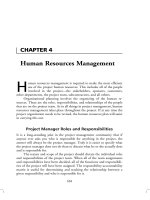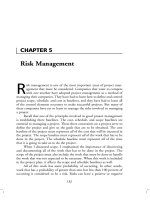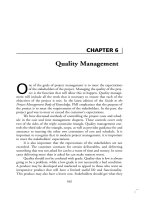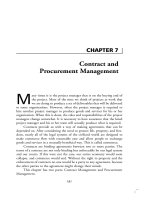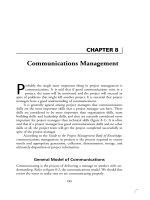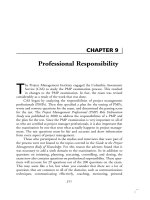Tài liệu Project Management Professional-Chapter 16b (Answer key) docx
Bạn đang xem bản rút gọn của tài liệu. Xem và tải ngay bản đầy đủ của tài liệu tại đây (73.18 KB, 7 trang )
QUALITY MANAGEMENT
1. Answer: d
Project quality management includes the processes required to ensure that the
project will satisfy the needs for which it was undertaken. It includes ‘‘all activi-
ties of the overall management function that determine the quality policy, ob-
jectives, and responsibilities and implements them by means such as quality
planning, quality control, quality assurance, and quality improvement, within
the quality system.’’
2. Answer: c
Projects are typically part of an organization larger than the project—
corporations, government agencies, health care institutions, international bod-
ies, professional associations, and others.
Projects are typically authorized as a result of one or more needs. These
stimuli may also be called problems, opportunities, or business requirements.
The central theme of all these terms is that management generally must make
a decision about how to respond.
Projects are authorized by upper management, which is responsible for
setting strategic company goals.
3. Answer: c
According to Juran and Deming, 85% to 95% of the quality problems that
occur in organizations are from processes controlled by upper management.
4. Answer: c
Quality programs save money. Each improvement in quality will yield benefits
to the project that are in excess of the cost of the implementation and operation.
5. Answer: b
Experiments are used to determine the impact of the different variables. The
design of the experiment is a controlled study of the problem. Holding all
variables constant and varying one of them is sensitivity analysis. The results
will show which variable has the most impact on the process.
354
9618$$ CH25 09-06-02 15:01:14 PS
355Quality Management
6. Answer: a
The averaging of the five parts that are sampled is called the X bar value. In
control charts the two values that are normally plotted on the control chart are
the X bar value and the R value, the difference between the highest and lowest
value of the dimension in the sampled parts.
7. Answer: c
This is the Guide to the PMBOK definition for quality. Stated and implied
needs are the inputs to developing the requirements of the product or output
from the project.
8. Answer: c
Quality assurance is all the planned and systematic activities implemented
within the quality system to provide confidence that the project will satisfy the
relevant quality standards.
9. Answer: b
Quality must be planned into the product, not inspected in. The design and
building of the product should be such that the quality will be designed or built
in rather than expecting the inspection of the product to catch the mistakes
and defects and rework them into a quality product.
10. Answer: c
Products that are able to perform and function acceptably but are different
technically are graded into different categories. For example, wood is graded
according to the number of knots that are present in the wood. The wood
performs the function of being structurally sound in all grades, but the desir-
ability of knot free wood leads us to higher grades of wood.
11. Answer: c
A Pareto diagram is a histogram, ordered by frequency of occurrence, that
shows how many results were generated by type or category of identified cause.
By using this tool the manager can identify the defects that occurred most
often.
12. Answer: c
This is a check sheet. Check sheets are simple devices that can be used almost
anywhere. On them you make a mark in the appropriate category. After many
9618$$ CH25 09-06-02 15:01:14 PS
356 Preparing for the Project Management Professional Certification Exam
marks are made, they can be added up to give the number of each defect passing
the point.
13. Answer: d.
Quality management and project management are very concerned about cus-
tomer satisfaction.
14. Answer: a
Common causes are those that are the normal variables produced in the process
output when the process is operating normally. Special causes are the causes of
variability in the process when the process is not operating normally.
15. Answer: a.
Work results, quality checklists, operational definitions, and the management
plan are the items listed in the Guide to the PMBOK as the inputs to the quality
control function.
16. Answer: b
The averaging of the five parts that are sampled is called the X bar value. In
control charts the two values that are normally plotted on the control chart are
the X bar value and the R value, the difference between the highest and lowest
value of the dimension in the sampled parts.
17. Answer: c
The diagram the manager is using is a cause and effect diagram, also known as
a fishbone diagram. These diagrams are often called Ishikawa diagrams as well.
18. Answer: b
This is an example of variable inspection. If the testing machine had had a light
that showed green when the parts were acceptable, then it would have been
attribute inspection. We don’t know whether sampling or 100% inspection is
taking place.
A variable is an actual measurement of some characteristic of a part. An
attribute is a yes or no determination of whether the part is good or bad.
19. Answer: b
One of the most important things in using control charts is that they not only
show when the process is out of control but also show when the process is in
9618$$ CH25 09-06-02 15:01:14 PS
357Quality Management
control and only normal variations are taking place. This means that we have a
guide that tells us when we should not be taking corrective action as well as a
guide to tell us when we should take corrective action.
20. Answer: b
In modern quality management the idea of making small incremental improve-
ments is used rather than making up large projects to make giant changes in
the operation.
21. Answer: b
Kaizen means improvement in Japanese. It actually applies to all aspects of life.
In terms of quality management it means continuing improvement involving
everyone, including managers and workers alike, from the top to the bottom of
the organization.
22. Answer: b
Cost and delays are reduced, production improves, market share increases, and
profits go up. Cost to the customer should not go up when quality management
is implemented properly. Capital expenditures should not necessarily go down
or up as a result of quality management. Profits should increase.
23. Answer: d
The benefits should always be greater than the cost of implementing quality
management. The benefit-cost ratio should always be greater than one.
24. Answer: a
The quality plan is part of the overall project plan and is an important input to
the project plan.
25. Answer: d
Quality assurance is all the planned and systematic activities implemented
within the quality system to provide confidence that the project will satisfy the
relevant quality standards.
26. Answer: b
The International Standards Organization attempts to ensure consistency in
organizations that can be relied upon by their customers. To qualify, an organi-
zation must meet six requirements regarding the control of documents, control
9618$$ CH25 09-06-02 15:01:15 PS
358 Preparing for the Project Management Professional Certification Exam
of records, internal audits, control of nonconformance, corrective action, and
preventive action.
27. Answer: c
The acceptance costs of quality are the things that must be done to ensure that
the quality of the product or service is acceptable. This includes the cost associ-
ated with inspection and reinspection, the cost of the quality plan, quality assur-
ance, and quality management.
28. Answer: a
The process is not in control. Although the values of X bar are all within the
upper and lower control limits of the process, there is a trend showing five
values in a row all increasing. There are several observations on the control
chart that can indicate that the process is out of control even though the values
measured are within the upper and lower control limits.
29. Answer: d
The Pareto diagram shows a histogram where the defect classes are arranged in
the order of the highest to lowest frequency of occurrence of the defect. It also
shows the cumulative percent of defects from the highest to lowest number of
defects.
30. Answer: b
In a scatter diagram a plot is made with two variables. If there is a correlation
between the variables and the two variables increase at the same time, it is called
positive correlation. If one variable increases while the other variable decreases,
it is called negative correlation.
31. Answer: d
The value of X bar for day number 7 is the sum of the four observed values for
day 7 divided by 4.
25 27 50 מ12
This is 90 / 4 or 22.5. Since this is the number of ten-thousandths of an inch,
the correct answer is .00225.
32. Answer: b
The value of R is the difference between the highest value recorded and the
lowest value recorded for the day.
9618$$ CH25 09-06-02 15:01:16 PS
359Quality Management
מ25 28 12 22
This value is 28 מ (מ25) or 53. Since this number is in ten-thousandths of
an inch the correct answer is .0053.
33. Answer: a
To calculate the value for R bar, we take the value for R for each day and find
the mean or average value.
Value for R for each day is:
Day12345678910
R 21 52 20 68 86 77 62 31 81 53
The sum of the values is 551, which is 55.1 when divided by 10. Since this
number is in ten-thousandths of an inch, the correct answer is .00551.
34. Answer: a
In sampling inspection the ideal operating characteristic curve would correctly
pass or reject all lots that were below or above the AQL point. Any lot that
truly had more than the allowed AQL would be rejected, and any lot that had
less than or equal to the AQL would be accepted.
35. Answer: a
When sampling inspection is used, it will discover lots that are above the AQL.
These lots are then returned for 100% inspection. When the 100% inspection
is done, the defective parts are removed, and the acceptable ones are sent to the
customer. As the number of defective parts increases, more lots will have to be
inspected 100%. Initially, the quality delivered to the customer will fall, but
because of the added work of the 100% inspection, the quality will then im-
prove.
36. Answer: d
Five years.
37. Answer: c
In the Shewhart and Deming cycle, an idea is first identified and planned for
implementation. Then an experiment is performed to see if the idea will work.
The results are checked, and then evaluated. If the evaluation is positive, the
idea is fully implemented, and the next idea is planned.
9618$$ CH25 09-06-02 15:01:16 PS
360 Preparing for the Project Management Professional Certification Exam
38. Answer: a
The Demming cycle refers to the process of making continuous improvements:
Plan, Do, Check, Act. In the Demming cycle we plan an improvement, and
then we attempt the new process with the change on an experimental level. We
check the results and then act to make the permanent improvement.
39. Answer: b
Because the parts are attribute inspected, we do not have data other than the
parts failed to pass a Go–No Go gauge. We only know that an unacceptable
number of parts were either above or below the allowed dimension. It is possi-
ble that the average for the rejected parts is 2.000 inches. The only thing we
know for sure is that the part diameters are greater than 0.000, or they would
not exist.
9618$$ CH25 09-06-02 15:01:17 PS



